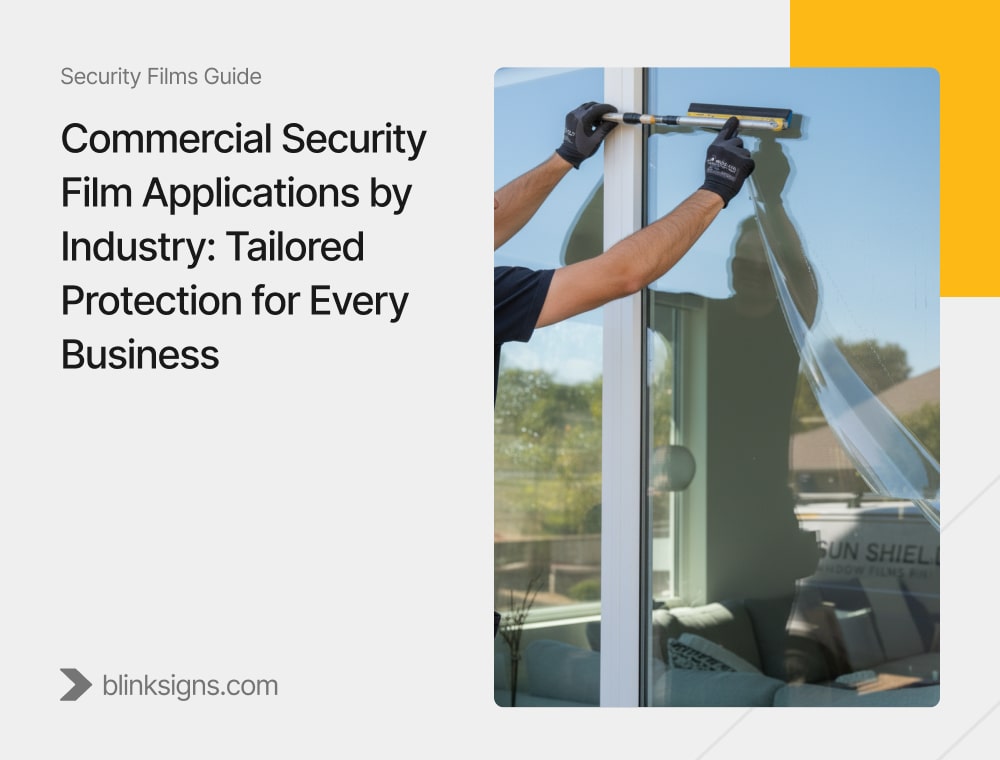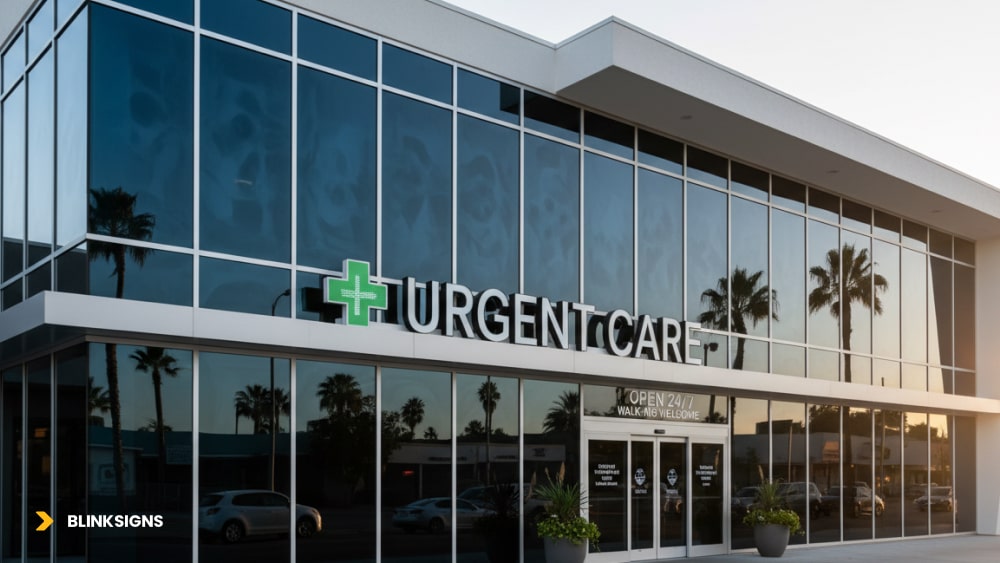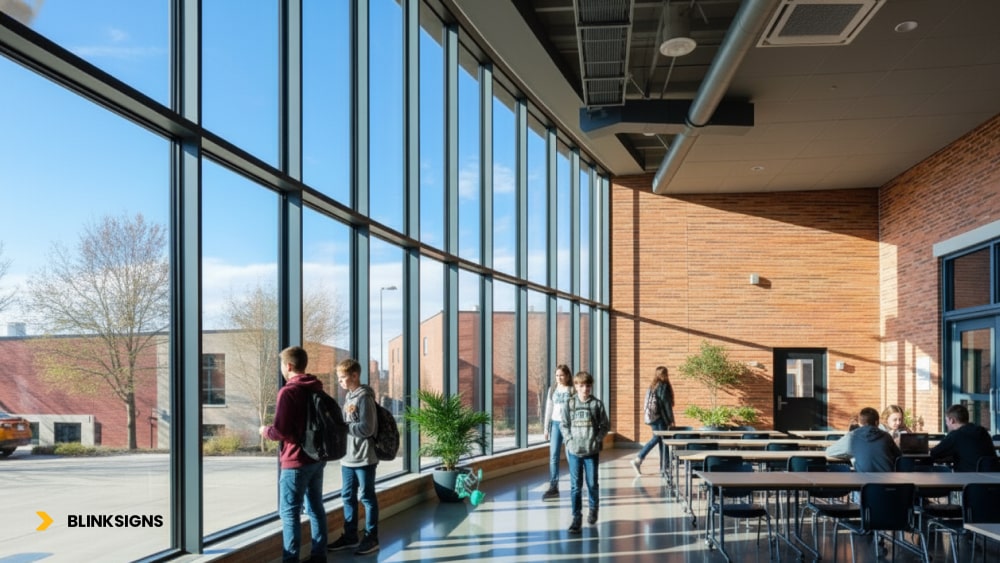
Commercial Security Film Applications by Industry: Tailored Protection for Every Business
Every commercial property faces a different kind of vulnerability. A retail storefront’s most significant threat might be a midnight smash-and-grab. A hospital’s concern could be protecting patient privacy while ensuring staff safety. Meanwhile, a courthouse or government office must withstand potential blast pressure or vandalism without compromising aesthetics.
Security window film answers all these challenges, but the right movie depends entirely on where and how it’s used. At BlinkSigns, we’ve seen firsthand across thousands of installations that an industry-specific application is the difference between partial protection and verified safety compliance.
This guide distills what business owners, facility managers, and architects need to know about applying commercial security films by industry, with insights drawn from FBI crime data, ANSI and GSA standards, and BlinkSigns’ field experience across the U.S.
Understanding Industry-Specific Threats
One-size-fits-all protection rarely works.
Each industry faces distinct risks and compliance mandates:
- Retail: Smash-and-grab theft, vandalism, and organized retail crime.
- Healthcare: Controlled-substance theft, patient privacy (HIPAA), and workplace violence.
- Education: Forced-entry delays, student safety, FERPA compliance, and funding limits.
- Government: Blast mitigation, vandalism resistance, and GSA/DoD certification.
- Corporate: Data protection, workplace security, and ESG energy performance.
- Banking, Hospitality, Religious sectors: Focus on robbery deterrence, guest safety, vandalism prevention, and storm resilience.
Retail & Commercial Storefront Applications

Retail & Commercial Storefront film Applications
Typical Threat Landscape
Retailers lose nearly $719,548 per $1 billion in sales due to organized retail crime (NRF 2024). Most break-ins occur within 30–60 seconds, targeting display windows and entry doors. Beyond theft, vandalism, and looting during civil unrest pose recurring risks for urban businesses.
Recommended Solutions
- 8–10 mil security film for standard storefronts.
- 12 mil reinforced film for jewelry, electronics, or luxury goods retailers.
- Anti-graffiti film as a sacrificial outer layer for high-traffic glass.
- Reflective privacy film for after-hours deterrence.
- A frame-anchoring system (IPA or silicone) is used for maximum retention strength.
BlinkSigns installations are tested against ANSI Z97.1 and CPSC 16 CFR 1201, ensuring legal recognition as safety glazing under building codes.
Business Impact
- Time delay: Extends forced-entry attempts from under a minute to 3–5 minutes — often enough to deter criminals.
- Insurance reduction: Certified installations can cut property premiums by 5–15 %.
- Loss avoidance: Prevented theft savings typically range from $8K to $20K per incident.
BlinkSigns Case Insight: A Chicago jewelry chain fitted with 12 mil film and anchoring reported three prevented break-ins in 18 months and a 12 % insurance premium decrease.
Healthcare & Hospital Applications

Healthcare & Hospital security film applications
Security & Compliance Challenges
Healthcare facilities face increasing security vulnerabilities driven by theft, patient-privacy risks, and workplace violence. According to OSHA and the U.S. Bureau of Labor Statistics, nearly 73% of all non-fatal workplace violence incidents occur in healthcare settings, making hospitals one of the highest-risk work environments:
- Controlled-substance theft from pharmacies.
- Medical equipment theft (laptops, diagnostic tools).
- Workplace violence — rates up to 5× higher than other industries.
- Patient privacy exposure through external windows (HIPAA violation risk).
Critical Protection Zones
- Pharmacy and medication storage areas.
- Emergency department entrances and waiting rooms.
- Psychiatric units and behavioral health windows.
- Patient rooms on ground floors or street exposure.
- Administrative offices handling patient data.
Recommended Film Specifications
- 8–12 mil safety film for patient areas and administrative offices.
- 12–15 mil reinforced film for pharmacies and high-risk departments.
- Privacy + security hybrids to meet HIPAA visual-privacy requirements.
- Frame-anchored systems for psychiatric or emergency zones.
BlinkSigns films meet Joint Commission safety expectations, OSHA workplace-violence standards, and NFPA 101 Life Safety Code guidelines.
ROI & Operational Benefits
| Metric | Average Result | Source |
| Controlled-substance theft prevention | $50K–$500K saved per incident | FBI Healthcare Crimes 2024 |
| Glass-injury claim reduction | 70 % fewer cases post-install | OSHA Safety Case Studies 2023 |
| HIPAA violation avoidance | $100–$50,000 per event avoided | HHS Enforcement Data 2024 |
| Energy savings (dual film) | $8K–$20K per year | ENERGY STAR Healthcare Facilities Survey 2023 |
BlinkSigns Example: A 15-facility regional hospital system installed 12 mil film in emergency departments and pharmacy zones — reporting zero theft events and 22 % energy-cost reduction in 18 months.
Education & School Security Applications

Education & School Security Film Applications
Unique Threat Profile
Schools face rising security concerns from K-12 campuses to universities that require solutions balancing safety and visibility. Forced entry, vandalism, and active-threat scenarios are among the leading motivators for security film adoption.
In recent years, many school districts have enhanced their physical-security protocols, with several states and safety agencies now recommending or funding security window film as a passive protection measure.
The Partner Alliance for Safer Schools (PASS) has also updated its national safety guidelines for K-12 Schools, to include security film and glazing as part of best-practice standards for securing school facilities.
Practical Applications
- 12–14 mil security film for entrances and ground-floor classrooms.
- 8–10 mil film for administrative offices and interior corridors.
- Reflective privacy films prevent visibility in classrooms after hours.
- Anchoring systems at primary access points for intrusion delay.
BlinkSigns installs school security systems that comply with FERPA privacy and PASS standards and local fire-marshal placement regulations.
Funding & ROI
Security projects for educational facilities increasingly rely on grants and federal programs such as the DHS Nonprofit Security Grant Program and FEMA Pre-Disaster Mitigation Funds.
With typical grant coverage reaching 50 – 75 % of installation costs, districts often realize a 2–4 year payback period purely from insurance and energy savings.
BlinkSigns Education Case Example:
A suburban district upgraded eight campuses with reflective and 12 mil films, funded 65 % through DHS grants. The district reported $47,000 in annual energy savings and zero successful break-ins two years post-installation.
Government & Municipal Facilities
Security & Compliance Environment
Public buildings demand both durability and compliance with national protection standards. Federal, state, and local agencies must adhere to GSA TS01 and ASTM F1642 blast-testing requirements and DoD Unified Facilities Criteria (UFC) for high-risk facilities.
Typical Use Cases
- Courthouses, embassies, and federal office buildings
- Police, fire, and emergency command centers
- Municipal halls and public service facilities
Recommended Solutions
- 12–15 mil blast-rated film tested to GSA Minimal-to-No-Hazard level.
- Structural silicone or IPA anchoring for frame retention.
- Anti-graffiti exterior coatings for street-level glass.
- Documentation package including ASTM/GSA test reports and installer certification.
Procurement & ROI Perspective
Government procurement prioritizes life safety and continuity. Even though the way costs are justified is different from private markets, ROI is gained by needing to replace glass less often, having lower liability, and recovering.
BlinkSigns Government Example:
A 30,000 sq ft federal courthouse retrofit achieved GSA Minimal Hazard certification and required no re-inspection corrections — saving weeks in project approval time.
Corporate Office & Commercial Security Film Applications

Corporate Office & Commercial Building Security Films Applications
Modern Corporate Security Needs
Today’s corporate environments face blended physical and digital risks — theft, workplace violence, and energy inefficiency.
Security film offers protection and performance by enhancing glazing strength and improving climate control.
Recommended Film Solutions
- 8–10 mil film for standard office façades.
- 12 mil film for reception, HR, or finance areas.
- Privacy/blackout films for executive and data-center zones.
- Energy-efficient hybrid films contribute to LEED v4 and Energy Star goals.
BlinkSigns helps corporate facilities align these installations with ESG reporting, Scope 2 emission reductions, and OSHA safety programs.
ROI Snapshot
| Benefit | Average Annual Value | Data Source |
| Energy savings | 10 – 20 % HVAC load reduction | DOE Commercial Buildings Survey 2023 |
| Insurance discount | 5 – 12 % property-premium reduction | Travelers & CNA Risk Reports |
| Productivity gain | 5 – 10 % fewer glare-related complaints | BOMA Occupant Comfort Study 2023 |
BlinkSigns Corporate Case Example:
A Fortune 500 headquarters installed 50,000 sq ft of 12 mil film, realizing 22 % energy cost reduction and zero break-ins over three years.
Other Key Commercial Sectors
Banking & Finance
Financial institutions require high-security glazing for teller areas and ATMs.
BlinkSigns installs 12–15 mil UL 972-certified films with frame anchoring to meet FDIC and insurer security mandates.
Typical ROI includes a 10–20 % premium reduction and near-elimination of glass-related losses.
Hospitality & Hotels
Hotels and resorts use 8–12 mil hurricane-rated films for guest safety, privacy, and energy efficiency. A beachfront client recorded zero window failures during a Category 3 storm and a 14 % annual energy reduction post-installation.
Religious & Community Facilities
Faith-based organizations rely on 8–10 mil anti-graffiti or 12 mil security films, often funded by DHS Nonprofit Security Grants.
These upgrades have prevented vandalism losses averaging $5,000–$50,000 per incident while preserving a welcoming appearance.
Cost & ROI Overview

Cost & ROI Overview
Cross-Industry Return Profile
| Industry | Primary ROI Driver | Typical Payback | Avg. Annual Savings | Compliance Standards |
| Retail | Theft prevention + insurance | 1.5 – 3 yrs | $8K – $20K | ANSI Z97.1 / CPSC 16 CFR 1201 |
| Healthcare | HIPAA liability + injury prevention | 2 – 3 yrs | $25K – $75K | HIPAA / Joint Commission / NFPA 101 |
| Education | Grant funding + safety ROI | 2 – 4 yrs | $5K – $15K | FERPA / State Safety Mandates |
| Government | Blast protection + continuity | Mandate based | Value of life safety | GSA TS01 / ASTM F1642 |
| Corporate | Energy & insurance savings | 3 – 5 yrs | $10K – $30K | LEED v4 / ESG / OSHA |
| Banking | Robbery deterrence + premium reduction | 2 – 4 yrs | $15K – $50K | UL 972 / FDIC Security |
| Hospitality | Guest safety + storm protection | 3 – 6 yrs | $8K – $25K | Miami-Dade NOA / Energy Star |
| Religious | Vandalism prevention + grant funding | 3 – 5 yrs | $5K – $12K | DHS Nonprofit Grant Program |
Data Sources: FBI Uniform Crime Report (2024); NRF Retail Crime Report (2024); DOE Energy Efficiency Survey (2023); BlinkSigns Installation ROI Tracker (2022 – 2024).
Lifecycle Value Insight
Professional installation (avg. $8–$15 per sq ft) delivers 45–65 % higher net ROI than DIY methods once energy, warranty, and maintenance are factored in.
Films typically last 10–15 years, maintaining clarity and performance with minimal upkeep.
Multi-Location Consistency & Enterprise Rollouts
Why Consistency Matters
For retail chains, hospital systems, and corporate networks, security film isn’t just a safety feature — it’s part of brand and compliance consistency.
Locations often install mismatched film types without centralized specification, which fail inspections or void warranties.
BlinkSigns solves this challenge by delivering nationwide consistency through standardized specifications, certified installation teams, and digital documentation across every site.
Enterprise Implementation Framework
| Rollout Stage | BlinkSigns Deliverable | Client Benefit |
| Assessment & Design | Multi-site risk & glazing audit | Unified specification for all branches |
| Procurement Coordination | Centralized vendor and compliance management | Cost efficiency + speed |
| Installation Oversight | Certified installers across states | Consistent artistry and warranty |
| Compliance Documentation | Digital test reports, GSA/ANSI certificates | Inspector-ready files |
| Post-Installation Support | Annual inspection + maintenance reminders | Long-term compliance assurance |
BlinkSigns’ project management system enables enterprise-grade quality control for portfolios ranging from five branches to 500+ facilities.
Each project is logged in a QR-linked compliance record, ensuring that maintenance teams and inspectors can verify standards instantly in the field.
The BlinkSigns Advantage
Certified Expertise
Every BlinkSigns installation is performed by manufacturer-certified professionals trained to handle leading film brands, including 3M, Madico, and XPEL.
Our technicians adhere to protocols derived from ANSI, CPSC, and GSA specifications, ensuring every application meets or exceeds code requirements.
Compliance-Centric Process
From hospitals with HIPAA-sensitive zones to federal facilities requiring blast-rated protection, BlinkSigns designs each project to satisfy legal and operational mandates.
We maintain archived certification data for every installation, giving clients verifiable proof of compliance during audits or insurance renewals.
Enterprise Reliability
BlinkSigns ensures continuity through standardized processes, national coverage, and scalable installation teams, whether a coastal hotel, multi-state retail chain, or government complex.
Our enterprise clients benefit from:
- Consistent documentation and maintenance scheduling.
- Centralized warranty management.
- Multi-site compliance verification and annual reporting.
Sustainability Integration
Security doesn’t come at the expense of sustainability.
BlinkSigns incorporates LEED v4 and Energy Star benchmarks into every assessment, helping clients align safety upgrades with ESG and carbon-reduction goals — an increasingly important factor for large property portfolios.
Industry-Tailored Protection That Performs
Every building has glass, but not every glass is protected the same way.
From retail storefronts and schools to hospitals and corporate campuses, the right security film transforms ordinary glass into a tested, compliant, and lasting layer of defense.
At BlinkSigns, we understand that security film is more than a material — it’s a long-term safety investment shaped by industry, compliance, and performance needs.
That’s why our experts combine engineering precision, verified certification, and multi-location expertise to help organizations confidently protect assets, people, and operations.
Call to Action
📞 Contact BlinkSigns today for an industry-specific consultation.
Our specialists will assess your facility, identify applicable standards (ANSI, HIPAA, GSA, or LEED), and design a compliant, cost-effective solution that strengthens security while enhancing your property’s value and performance.
BlinkSigns — Where safety, compliance, and design meet.